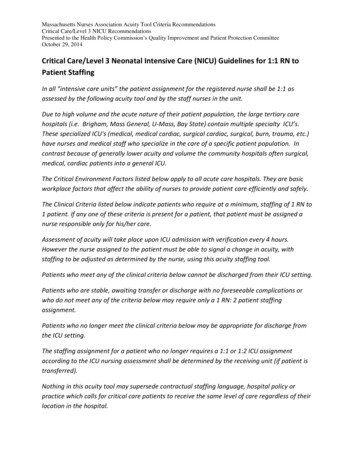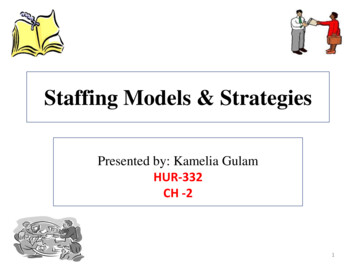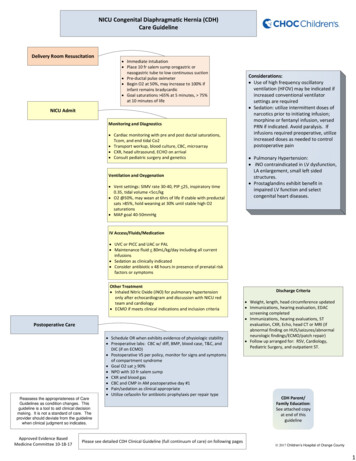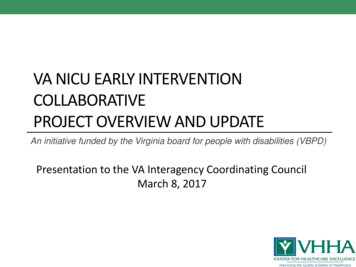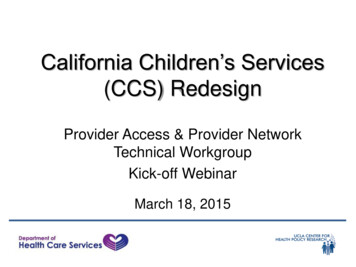
Transcription
RN Staffing in the NICUPosition Statement#3074NANN Board of DirectorsSeptember 2021Appropriate staffing is required to deliver safe and effective care to NICUpatients: vulnerable infants who are wholly dependent on their caregivers.A sufficient number and appropriate mix of qualified registered nurses(RNs) are needed in subspecialty NICUs (Levels II, III, and IV). However,evidence suggests understaffing is a substantial problem, one that putspatients at increased risk of missed or rationed care, medical incidents,disparities of care, and morbidity and mortality. As the professional voice ofneonatal nurses, the National Association of Neonatal Nurses (NANN)recommends staffing be based on the acuity of the population served andthat the principles of staffing and finance be shared with frontline nurseswho then have a say in the development of staffing policies.
Association PositionThe delivery of safe and effective neonatal nursing care requires the assurance of asufficient number and an appropriate mix of qualified registered nurses (RNs) to attendto the emergent and complex care requirements of critically ill and convalescent infantsin subspecialty NICUs (Levels II, III, and IV).BackgroundThe issue of staffing is not a new one. In Notes on Nursing, Florence Nightingale (1859)observed that “bad sanitary, bad architectural, and bad administrative arrangementsoften make it impossible to nurse” (p. 59). She went on to discuss what nursing is and isnot, describing elements of care that we consider essential to modern nursing care andneonatal nursing care: attention to cleanliness, sanitation, warmth, and nutrition. Morethan 160 years later, health care has become increasingly complex, and nursing careremains the most essential component of that care.Health care continues to evolve, and so do nursing services. The 2010 PatientProtection and Affordable Care Act, commonly called the Affordable Care Act (ACA),aims to provide comprehensive health care to citizens of the United States. With theenactment of the ACA have come inevitable changes in the delivery of nursing servicesas more citizens become eligible for affordable care. In 2011, the Institute of Medicine(IOM)—now the National Academy of Medicine—published The Future of Nursing,which addresses issues facing the profession, including staffing. There is evidence of adirect link between nursing care and higher quality of care, including improved patientsafety.According to the American Nurses Association (ANA), appropriate nurse staffing can becharacterized as “an ever-present challenge of managing the delicate balance of thepolarities of mission (improving population health and the quality and satisfaction forpatients, clinicians, and staff) and margin (operations and per capita cost of healthcare)” (ANA, 2020, p. 5). Appropriate nurse staffing is defined as a match of registerednurse expertise with the needs of the recipient of nursing care services in the context ofthe practice setting and situation (ANA, 2020 p. 6).In 2020, ANA revised its Principles for Nurse Staffing. The five principles are designedto help nurses at all levels develop and implement appropriate staffing plans. They are Characteristics and considerations of the healthcare consumer or patient Characteristics and considerations of registered nurses and otherinterprofessional team members and staff The context of the organization and workplace culture in which nursingservices are delivered The overall practice environment that influences the delivery of care Evaluation of staffing plans, overall costs, effectiveness, and resourcesexpended for nursing care (ANA, 2020, p. 65).
ANA also delineates seven core components of appropriate nurse staffing, including Registered nurses are full partners working with other healthcare professionalsin the collaborative, interprofessional delivery of safe, quality health care. All settings should have well-developed staffing guidelines with measurablenurse-sensitive outcomes specific to that setting and healthcare consumerpopulation that are used as evidence to guide daily staffing. Registered nurses at all levels within a healthcare system must have asubstantive and active role in staffing decisions to assure the availability of thenecessary time with patients to meet care needs and overall nursingresponsibilities. Staffing needs must be determined based on an analysis of consumerhealthcare status (eg. degree of stability, intensity, and acuity) and theenvironment in which the care is provided. Other considerations includeprofessional characteristics, competencies, experience, and skillset; staff mix;and previous staffing patterns that have been shown to improve care outcomes. Appropriate nurse staffing should be based on allocating the appropriatenumber of competent practitioners to a care situation, meeting consumercentered and organizational outcomes, pursuing quality of care indices, meetingfederal and state laws and regulations, and assuring a safe, high-quality workenvironment. Cost-effectiveness is an important consideration in the delivery of safe, qualitycare. Nurse leaders must evaluate and balance patient care needs and theoverall nursing care resources and costs expended for care. Reimbursement structures should not influence nurse staffing patterns or thelevel of care provided (ANA, 2020, p. 6).SignificanceThe significance of safe and appropriate staffing in the NICU cannot be understated.The breadth of this population is substantial, ranging from the most immature, small,and/or medically complex patients to infants who are growing and convalescing. Whatdifferentiates the NICU population from most other populations is that 100% of the NICUpopulation is 100% dependent upon their caregivers for all care and activities of dailylife. There is evidence that understaffing relative to national guidelines is a substantialproblem. Rogowski et al. wrote in 2013 that “in 2009, 55% of units understaffed at least25% of their infants and 16% understaffed at least 50% of their infants” (p. 447). This isa substantial risk to the care of these very high-risk infants. The neonatal population isalso particularly vulnerable to events requiring emergency measures, includingmetabolic disturbances, respiratory emergencies, and cardiovascular events. The needfor resuscitation can occur at any time during hospitalization, and adequate andappropriate staffing is required for the necessary care to be provided.Missed Care/Rationing CareNurses’ ability to deliver highly reliable care to their patients is critical for sustaining andimproving the quality of care. Missed care interferes with the ability to improve the carethat is delivered and, therefore, the outcome. Hart et al. (2019) define nursing workload
as the time that nurses devote to direct and indirect patient care, workplace activity aswell as professional development. Care that is either omitted or delayed is commonlytheorized to be an outcome of high nursing workload (Tubbs-Cooley et al., 2019). Thishigh nurse workload can be the result of more assigned patients, higher acuity scores ofthe individual patients, or higher subjective ratings of workload. In the 2019 studyconducted by Tubbs-Cooley et al., missed care was reported at the end of a shift,resulting in less than 1% missing data. Missed care was reported in 98.2% of thenursing shifts. Nurses had patient loads as high as 1:4 (nurses:patients); the meannursing ratio was 1:2. In 24% of corresponding infant-nurse shifts (2,502 of 10,428infant shifts), missed care was reported. Nurses most commonly reported missinghourly checks of IV lines and adherence to CLABSI bundles. Interestingly, this studymeasured subjective workload using the NASA Task Load Index (NASA-TLX) andfound that nursing ratios were not the only driver of missing care and that subjectiveassessment of workload needs was a largely unmeasured and yet predictive aspect ofnursing care that led to missed care.Medical IncidentsWithin the context of a study evaluating overtime utilization, nursing provision, and unitoccupancy rate, Beltempo et al. (2018) evaluated medical incidents, mortality, or majormorbidity among very preterm infants born at less than 29 weeks gestational age or aweight of less than 1000 grams. In this study, the rate of medical incidents wasassessed as an indicator of quality of care. Medical incidents were defined as“observable errors in the process of care with or without direct consequences on thepatient’s health” (Beltempo et al., 2018, p. 176). They found medical incidents occurredon days with lower median nursing provision ratios.Disparity in CareThe National Academy of Medicine found that “bias, stereotyping, prejudice and clinicaluncertainty on the part of healthcare providers may contribute to racial and ethnicdisparities in healthcare” (Horbar et al., 2019, p. 459). In the United States, being Blackand having low socioeconomic status are major risk factors for preterm birth and areoften linked to inadequate access to prenatal care (Engelhardt et al., 2018). Asystematic review on racial and ethnic health disparities found that very low birth weight(VLBW) infants born in high-black concentration hospitals have higher rates of infection,discharge without breast milk, and nurse understaffing (Lake et al., 2015). Thesestructural barriers likely translate to higher risk-adjusted VLBW infant mortality andmorbidity rates (Sigurdson et al., 2018). Structural racism refers to policies, laws, andregulations that systematically result in different access to opportunities based on race.Structural racism paired with social determinants of health can result in healthcareinequities (Johnson, 2020).Infants born in hospitals with a high concentration of black babies experiencedsignificantly higher patient-to-nurse ratios and had worse outcomes (Sigurdson et al.,2019; Lake et al., 2018). This is concerning as inadequate staffing leads to missed carewhich can negatively impact outcomes. Nurses in NICUs with a high percentage of
black babies missed 50% more activities than in NICU’s with a low percentage of blackinfants, which were a result of a higher patient-to-nurse ratio (Lake et al., 2018).Having a global understanding of how healthcare systems operate, including thedissimilar settings in which healthcare professionals and their patients live and work isimperative in understanding how residential segregation impacts access to care andquality of the health-care system and provider (Bailey et al., 2017). The patient-to-nurseratios and missed care in minority-serving hospitals were much higher than in otherhospitals, suggesting that improving staffing and workloads would improve quality ofcare at minority-serving hospitals (Beck et al., 2020).Morbidity and MortalityBeltempo et al. (2018) found that in infants born at less than 29 weeks gestational ageor less than 1000 grams weight, the risk of developing the composite outcome ofmortality or major morbidity is lower for infants who had high nursing provision ratios.This is true for the infants’ first day, first week, and entire NICU hospitalization. Becausecritically ill infants are a high-risk and unique population for which nurses providecontinuous care, the consequences of errors or missed care can be substantial. Inaddition, fragile neonates who are exposed to adverse events are more likely toexperience long-term morbidity (Hart et al., 2019).Watson et al. (2016) studied the effect of one-on-one care in a tertiary-level NICU. Thisstudy found an increased mortality rate in this NICU when a decreased proportion ofintensive care days was provided as one-on-one care. Utilizing their estimation ofdecreased mortality rate, they estimated that the cost of providing this level of care perlife saved was the equivalent of 16,678 (in 2016 dollars). Hart et al. (2019) evaluatedinsufficient staffing in the NICU and determined that it is associated with missed nursingcare. When important and necessary nursing care is missed in the NICU, adverseevents and poor patient outcomes are more likely. Neuraz et al. (2015) assessed theimpact of the patient-to-nurse ratio and workload on ICU mortality, noting that the risk ofdeath is increased significantly the higher the number of patients allocated to eachnurse. Lake et al. (2020) found that 49% of nurses missed at least one nursing careactivity with increased acuity load compared to only 27% with low acuity workload.Missed nursing care is defined by the study as “required nursing care that is omitted ordelayed” (Lake et al., 2020, p. 451). The authors stated that “any missed nursing carehas the potential to compromise infant health outcomes in the hospital and in the futureas infants grow and develop” (Lake et al., 2020, p. 451).Reducing the incidence of morbidity is possible and carries with it substantial benefit tothe infant, the family, and society as a whole. The likelihood of good long-term healthand neurodevelopment is greater than 90% if a VLBW infant is discharged to homewithout any major morbidity (Kaempf et al., 2019). Major morbidities, as describedbelow, are sensitive to nurse staffing and represent a significant burden.
InfectionNeonatal sepsis is a preventable morbidity associated with increased mortality,increased length of stay, and neurodevelopmental impairment. Appropriate nursestaffing in the NICU is associated with decreased rates of central line-associatedbloodstream infections (Cimiotti et al., 2006).Rogowski et al. (2013) measured understaffing in a variety of units relative to acuitybased guidelines; their data suggested substantial NICU nurse understaffing relative tonational guidelines, an understaffing that is higher among high-acuity infants. In thislarge data set, consisting of 67 hospitals and more than 10,000 infants over 2 years,understaffing was associated with an increased risk of nosocomial infections. Theypredicted that the infection rate in a unit with no understaffing was 9% compared to 14%at aa unit at the median understaffing rate; at the 90th percentile of understaffing, thepredicted infection rate rose to 21% (Rogowski et al., 2013).Hospitals have often used overtime to improve staffing during periods of insufficientstaffing. Beltempo et al. (2017) studied nursing staffing, overtime, and unit occupancy,and these factors’ effects on hospital-acquired infections. They found increased odds ofinfection following days of increased overtime utilization, even when controlling for unitconfounders. This is consistent with evidence from adult populations, where increaseduse of overtime is associated with greater fatigue and lower task performance. Fatigueis an important issue for nursing in all clinical areas and beyond the scope of thisstatement.ROPRetinopathy of prematurity (ROP) is a vasoproliferative disorder that has beenassociated with oxygen exposure in premature infants (Higgins, 2019). Efforts to reduceROP rates and severity have focused on tight oxygen targeting. Until recently, theoptimal oxygen saturation levels were not known. The Surfactant, Positive Pressure,and Oxygenation Randomized Trial (SUPPORT trial) and Benefits of Oxygen SaturationTargeting (BOOST II trial) resulted in findings of increased mortality when infants weremanaged at the low oxygen target level. In the case of the BOOST trial, it resulted inhalting the study early. In a recent meta-analysis, the lower SpO2 target range wasassociated with a higher risk of death and necrotizing enterocolitis but a lower risk ofROP treatment (Askie et al, 2018).Episodes of oxygen desaturation are common in preterm infants and must beresponded to promptly to maintain appropriate oxygenation levels in these vulnerableinfants. Automated adjustment of oxygen is available only as an experimental device(Waitz et al., 2015) that is unlikely to soon be available for general use. Thus, nursesmust be available to respond efficiently to out-of-range alarms. Response to out-ofrange events and the effect it has on ROP has been evaluated as part of qualityimprovement studies. Gentle et al. (2020) evaluated the use of monitor histograms toalert nursing staff to the duration of time infants spent out of range; the studydocumented an increase in the amount of time spent in the target zone (48.7% to
57.6%) and a decrease in the rate of the outcome “death or severe ROP” (32.1% to18%).BPDAn association between staffing and the specific outcome of bronchopulmonarydysplasia (BPD) has not been studied. However, in a study by Beltempo et al. (2018),the composite outcome of death from all causes and major morbidity was associatedwith lower nursing provision ratios. The authors state that “association of the nursingprovision with the composite outcome was mainly related to the bronchopulmonarydysplasia rates, the two being inversely related” (Beltempo et al., 2018, p. 177 ). Thedata support the need for a nurse’s workload to be aligned with each patient’s uniqueneeds; in this case, the nurse must be able to comply with meticulous respiratory orBPD practice guidelines.Oxygen targeting issues that affect ROP rates also affect BPD rates. Additionally, theSUPPORT trial (2010) found that the use of noninvasive ventilation or continuouspositive airway pressure (CPAP) is associated with the reduction in rate of BPD. Thisstrategy requires increased nursing time because this population requires meticulousmonitoring of physiologic status to prevent undesirable outcomes such aspneumothorax or nasal trauma (Roberts, 2011).FeedingOne of three major tasks a premature or sick infant must accomplish to be dischargedfrom the NICU is feeding. Preterm infants at term equivalent age are more likely to havefeeding difficulties than term infants. They may experiencepoor arousal, poor tongue positioning, suck–swallow–breathe discoordination,inadequate sucking bursts, tonal abnormalities, discoordination of the jaw andtongue during sucking, lack of positive engagement or discomfort, signs ofaspiration, difficulty regulating breathing, and inability to maintain an appropriatestate and complete the feeding (Pineda et al., 2020, p. 650).Late-preterm infants, who may be physiologically stable, may require considerableattention related to enteral feeding. Supporting breastfeeding throughout all infantgestations also can be time intensive (McGrath et al., 2010).A diet of maternal breast milk has been associated with a decreased risk of necrotizingenterocolitis. In a study evaluating the use of quality improvement methods to reduceNEC, Gephart and Quinn (2019) found that maternal lactation support is paramount tothe delivery of NEC prevention practices. Education, instruction, support, andencouragement from skilled nursing staff are essential components to ensuringbreastfeeding success which protects the health of babies and their mothers.In a study evaluating NICU work environments, Hallowell et al. (2016) found that NICUswith better work environments, better educated nurses, and more infants who receivebreastfeeding support from nurses have higher rates of VLBW infants discharged home
on human milk. All of these factors contribute to feeding success in convalescentinfants in the NICU and require available staff to accomplish this important milestone fordischarge,Acuity ScoringRogowski et al. (2015) identified the NICU as a setting with a high nurse-to-patient ratioand determined that in this highly intensive setting, these staffing patterns may notoptimize patient outcomes. They found that infant acuity was the sole determinant ofnurse workload. The presence of other members of the care team was not associatedwith nurse-to-infant ratios, and nurse education, experience, and specialty certificationwere not reflected in nurse-to-infant ratios. Identifying the determinants of nurse staffingbased on acuity measurement was an important first step in understanding howoutcomes can be improved through adequate nurse staffing levels.Al-Dweik and Ahmad (2019) stated that “linking nursing shift assignments to patients’acuity scores may increase the workload balance, achieve equitable nursingassignments, and nurses’ satisfaction” (p. E34). Their utilization of a patient acuity scoreshowed significant improvement in balanced work assignments, potentially improvingsatisfaction in the areas of workload and standards of nursing care. By using a datadriven acuity-based approach to staffing, nursing care performance can be measured atthe individual patient level to customize care while optimizing staffing practices (Welton,2017).Utilizing an evidence-based approach, NICU nurses must participate in all levels ofstaffing within an organization in order to support the high acuity and low volumefluctuations experienced. There is no standardized risk assessment tool or establishedclinical indicators that allow for the clear identification of equitable assignmentdistribution that ensures safe delivery of nursing care. Rather than utilizing traditionalnurse-to-patient ratio-based assignments, nurses have an extensive interest inoperationalizing a process to achieve staffing effectiveness and a healthy workenvironment.Proper technologies are needed to support, capture, and communicate patientassignments and patient workload in order to balance economics and quality outcomes.Addressing unique ICN patient needs and the varying needs of patients with differentacuity levels can be done by utilizing scoring as a vehicle to determine patientrequirements. Ingram and Powell (2018) stated assigning a level of care according topatient needs addresses issues of unbalanced assignments and allows nurses toinfluence decision-making as stakeholders while building a standard of care. Al-Dweikand Ahmad’s 2019 evidence suggests acuity-based assignments affect patient safety,productivity, patient outcomes, and quality of care—identifying communication, fairdistribution, and assignment transparency as key elements.
Nursing workload is an important aspect of NICU nursing that remains largelyunmeasured despite the potential for significant intervention (Tubbs-Cooley et al.,2019).RecommendationsIt is clear that staffing rates matter. Data show that improvement in staffing improvesoutcomes on multiple levels. This supports stronger staffing ratios. It also is clear thatminimal staffing ratios and optimal staffing ratios are different.We believe that every infant under our community of care should have staffing based ontheir physiological and psychosocial needs. We, as a community, must work toeliminate inequities where they exist. Inequities in care delivery are unacceptable.When minimum staffing ratios are set by states, they must be followed, but minimumstaffing ratios are just that: minimums. Exceeding minimum staffing ratios is allowableand may be required.NANN makes the following recommendations regarding appropriate RN staffing ofsubspecialty NICUs (Levels II, III, and IV).1. ANA’s Principles for Nurse Staffing (3rd Ed.) should inform decisions about RNstaffing in units where care is given to critically ill and convalescent newborns.2. Staffing guidelines should be based upon the acuity of the population served.There are few acuity tools developed for NICUs and their applicability from unit tounit has not been established. Nonetheless, the principles of measuring andaccounting for acuity are applicable. We recommend each unit evaluate theiracuity in a standardized manner with the goal of evaluating nurse-centeredoutcomes and care delivery, not resource utilization. The goals of any acuityassessment are to allocate an appropriate number of staff to meet unit andorganizational goals, pursue quality indices, meet regulatory requirements, andassure a safe, high-quality work environment. Skillset, staff mix, experience, andcompetencies all play a role in staffing and should be considered when assessingadequacy of any safe staffing plan. Family care, teaching, and support also mustbe considered in acuity assessment.3. Because populations and care trends change, we recommend periodic evaluationof the effectiveness of the individual strategy or tool used for measuring acuity.Additionally, we recommend evaluating the unit staffing adequacy to determine ifunits are meeting staffing goals and patient needs on an ongoing basis. Evaluationof staffing plans should include real-time capturing of missed care. When missedcare events occur, they should be evaluated in sum as an opportunity to discernpatterns. When patterns are found, staffing plans should be adjusted or systemsshould be created to mitigate the frequency of missed care.4. Development of staffing policy should include formal input from frontline staff incollaboration with nursing administration. The frontline staff’s role and proximity tothe patient and family provide a unique perspective that must be considered. This
should be a goal for all phases of staffing: planning, implementation, problemsolving, and evaluation of effectiveness. Staff participation in staffing-policydevelopment is an important expectation of appropriate staffing, one of sixcomponents of a healthy work environment as defined by the AmericanAssociation of Critical Care Nurses (Blake, 2015).5. Staff nurses at all levels involved in staffing decisions should learn about principlesof staffing and finance. Financial stewardship is a balance between judicious useof resources and appropriate allocation of resources. Both frontline providers andhospital administration have a responsibility in this regard. A financially exhaustedhealthcare system serves no one’s needs. Increasingly, the concept of “value” iscited in making decisions about resource utilization. Value has been defined as“providing the optimal outcome per health dollar spent. Improving the value ofhealth care for patients and healthcare organizations requires an understandingand evaluation of the costs and benefits” (Fischer & Duncan, 2020, p. 972). Thisrequires that facilities be transparent regarding factors influencing budgets forstaffing. We recommend that facilities utilize existing technologies to evaluatedrivers of acuity and support capture of staffing issues, missed care, and adverseoutcomes. The goal is to develop strategies to assist staff with these clinicalsituations. In some instances, nurse extenders may augment but not replacenurses if permitted by local regulations.6. Census and acuity fluctuations occur; therefore, staffing needs must be tailored tocreate an equitable and effective method of responding to these changes in orderto support a healthy work environment for staff while providing quality patient care.A staff-driven initiative which addresses reserve capacity as well as establishedand effective float guidelines for staffing will ensure a consistent practiceenvironment. Each unit must develop a process to identify, optimize, and utilizestaffing resources. These guidelines will provide a flexible staff floating policy andan order of staff reduction as needed for low census. In units with low patientvolumes, a sufficient quantity of staff must be available to immediately respond toemergencies. This means they must be immediately available although they canhave other responsibilities, activities that can be temporarily abandoned withoutconsequence, that allow them to respond if and when an emergency occurs. Anestablished list of projects, educational modules, quality initiatives, unit policiesand guidelines, chart reviews, and clinical practice updates will leave staffavailable to respond to emergency situations in times of low census whileimproving the clinical practice environment and promoting organizational success.7. Situations involving neonatal specialty care for fewer than six intermediate-carepatients or four or fewer intensive care patients require a minimum of two RNs withneonatal expertise and training.8. Though research about nurse staffing and outcomes in the neonatal populationhas increased over the past decade, the issue of how to measure acuity and applyit to the NICU environment continues to need attention. This population, likeothers, is rapidly changing; smaller and less mature infants are becoming more
commonplace. As the population and technology evolve, we must continue to dothe same.ReferencesAl-Dweik, G., & Ahmad, M. (2019). Matching nursing assignment to patients’ acuitylevel: The road to nurses’ satisfaction. Journal of Nursing Measurement, 27(1),E34-E47. https://doi.org/10.1891/1061-3749.27.1.E34American Nurses Association. (2020). ANA’s Principles for Nurse Staffing (3rd -nurse-staffing-ebook.Askie, L. M., Darlow, B. A., Finer, N., Schmidt, B., Stenson, B., Tarnow-Mordi, W.,Davis, P. G., Carlo, W. A., Brocklehurst, P., Davies, L. C., Das, A., Rich, W.,Gantz, M. G., Roberts, R. S., Whyte, R. K., Costantini, L., Poets, C., Asztalos, E.,Battin, M., Halliday, H. L., Neonatal Oxygenation Prospective Meta-analysis(NeOProM) Collaboration. (2018). Association between oxygen saturationtargeting and death or disability in extremely preterm infants in the neonataloxygenation prospective meta-analysis collaboration. JAMA, 319(21), 21902201. https://doi.org/10.1001/jama.2018.5725Bailey, Z. D., Krieger, N., Agénor, M., Graves, J., Linos, N., & Bassett, M. T. (2017).Structural racism and health inequities in the USA: Evidence and interventions.The Lancet, 389(10077), 1453-1463. https://doi.org/10.1016/S01406736(17)30569-XBeck, A. F., Edwards, E. M., Horbar, J. D., Howell, E. A., McCormick, M. C., & Pursley,D. M. (2020). The color of health: How racism, segregation, and inequality affectthe health and well-being of preterm infants and their families. PediatricResearch, 87(2), 227-234. https://doi.org/10.1038/s41390-019-0513-6Beltempo, M., Blais, R., Lacroix, G., Cabot, M., & Piedboeuf, B. (2017). Association ofnursing overtime, nurse staffing, and unit occupancy with health care–associatedinfection
RN Staffing in the NICU . Position Statement #3074 . NANN Board of Directors . September 2021 . . There is evidence that understaffing relative to national guidelines is a substantial problem. Rogowski et al. wrote in 2013 that "in 2009, 55% of units understaffed at least


